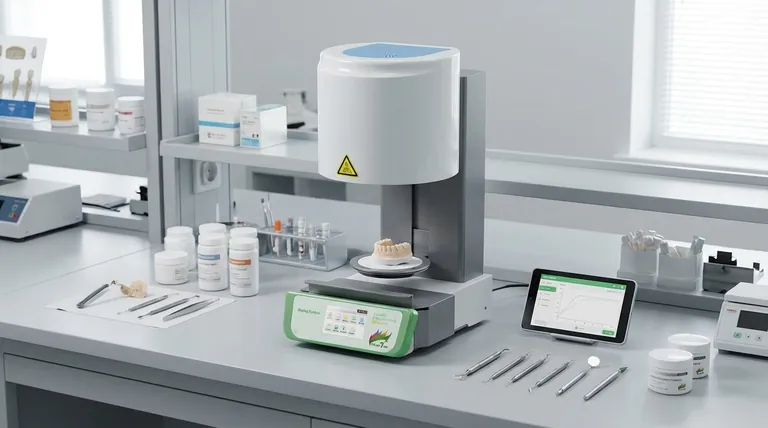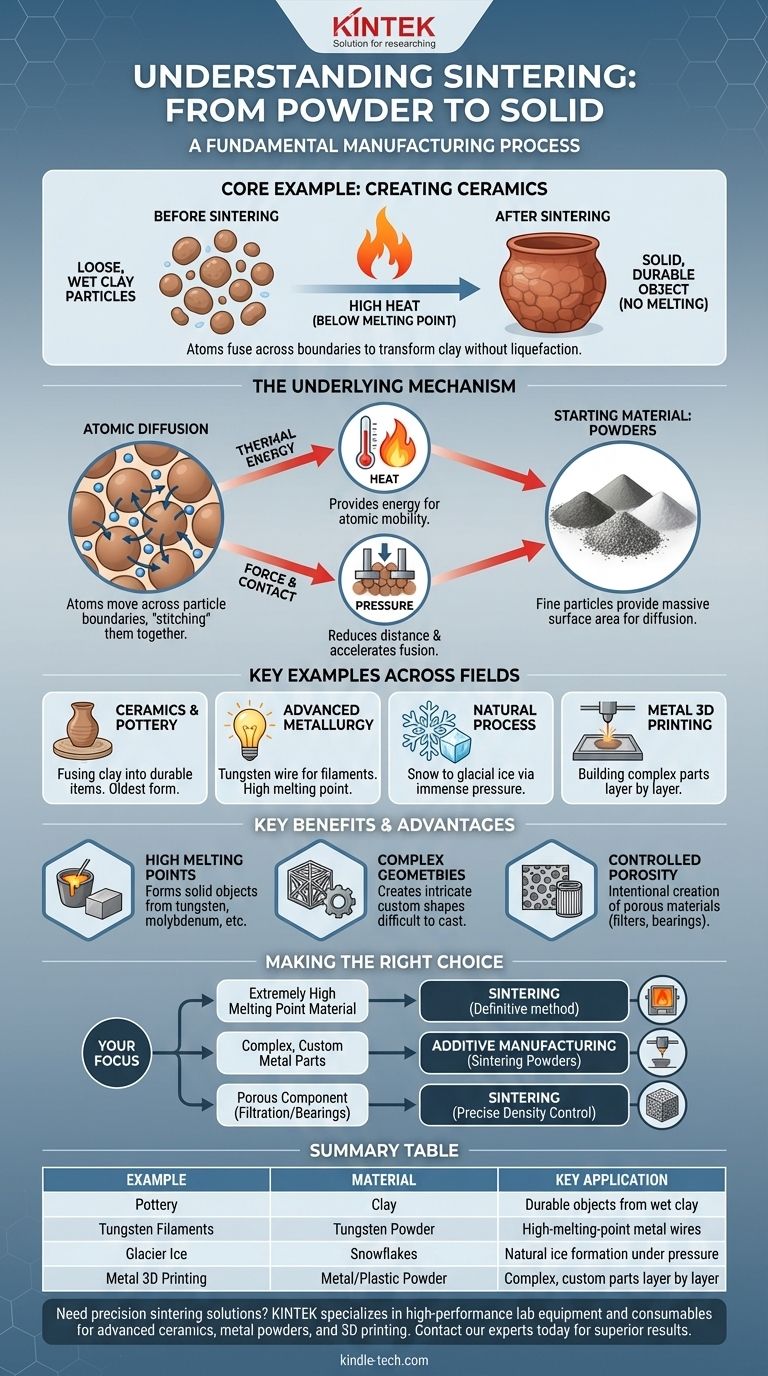One of the most common examples of sintering is the creation of ceramics. When clay is fired in a kiln, the individual clay particles are heated to a high temperature, causing their atoms to fuse together across their boundaries. This process transforms the loose, wet clay into a single, solid, and durable object without ever melting the material into a liquid state.
Sintering is a fundamental manufacturing process that uses heat and/or pressure to fuse small particles into a solid mass. The key principle is that this transformation occurs below the material's melting point, relying on atomic diffusion to create a single, cohesive piece.

What is Sintering at a Deeper Level?
To truly grasp the concept, it's essential to understand the underlying mechanism that makes sintering possible for materials ranging from ancient pottery to modern jet engine components.
The Core Mechanism: Atomic Diffusion
Sintering works by encouraging atoms from individual particles to move and migrate across the boundaries where the particles touch. This atomic movement effectively "stitches" the particles together on a microscopic level.
The process bonds adjacent powder particle surfaces, gradually eliminating the empty spaces between them and increasing the density of the final object.
The Role of Heat and Pressure
Heat provides the thermal energy necessary to make the atoms mobile enough to diffuse across particle boundaries.
Pressure serves a complementary role by forcing the particles into close contact, which reduces the distance atoms need to travel and accelerates the fusion process. Some forms of sintering rely almost entirely on pressure, while most industrial applications use a combination of both.
The Starting Material: Powders
The process almost always begins with a material in a powdered form. This includes metals, ceramics, plastics, and other materials.
The fine particles provide a massive amount of surface area, which is critical for promoting the atomic diffusion that lies at the heart of the sintering process.
Key Examples Across Different Fields
While ceramics are a classic example, sintering is a versatile process with applications in nature, history, and cutting-edge technology.
Manufacturing: Ceramics and Pottery
This is the oldest form of sintering, dating back thousands of years. The firing process integrates discrete blobs of wet clay into a single, durable item by fusing the particles together.
Advanced Metallurgy: Tungsten Filaments
Sintering became a critical industrial process in 1909 for producing ductile tungsten wire for light bulb filaments. Tungsten's extremely high melting point makes it nearly impossible to melt and cast, so sintering powdered tungsten was the breakthrough solution.
A Natural Process: Snow to Glaciers
A simple, pressure-driven example of sintering occurs in nature. The immense pressure at the bottom of a snowpack compacts snowflakes, forcing their crystalline boundaries to fuse and eventually form solid glacial ice. Pressing loose snow into a hard snowball is a small-scale version of this same effect.
Modern Technology: Metal 3D Printing
Many forms of additive manufacturing use sintering. A machine lays down a thin layer of metal or plastic powder, and a laser or other heat source selectively sinters the particles to form a solid layer. This process is repeated layer by layer to build a complex, three-dimensional object.
Understanding the Key Benefits
Sintering is not just an alternative to melting and casting; it offers unique advantages that make it the only viable option for certain applications.
The Primary Advantage: High Melting Points
The most significant benefit of sintering is its ability to create solid objects from materials with exceptionally high melting points, such as tungsten and molybdenum. Melting these materials is often impractical or prohibitively expensive.
Creating Complex Geometries
Paired with technologies like 3D printing, sintering allows for the creation of intricate custom shapes that would be difficult or impossible to produce with traditional casting or machining methods.
Controlling Material Porosity
Because sintering starts with discrete particles, the final density can be controlled. This allows for the intentional creation of porous materials, which are essential for products like filters and self-lubricating bearings.
Making the Right Choice for Your Goal
Understanding when to leverage sintering is key to solving specific engineering and manufacturing challenges.
- If your primary focus is shaping a material with an extremely high melting point: Sintering is the definitive and often only practical method to form a solid part.
- If your primary focus is producing complex, custom metal parts: Additive manufacturing techniques that rely on sintering powders are the leading solution.
- If your primary focus is creating a porous component for filtration or bearings: The sintering process provides precise control over the final density and porosity of the material.
Ultimately, sintering is a powerful and fundamental process for transforming powders into solid objects without the need for liquefaction.
Summary Table:
| Sintering Example | Material Used | Key Application |
|---|---|---|
| Pottery & Ceramics | Clay | Creating durable, solid objects from wet clay |
| Tungsten Filaments | Tungsten Powder | Manufacturing high-melting-point metal wires |
| Snow to Glacier Ice | Snowflakes | Natural formation of solid ice under pressure |
| Metal 3D Printing | Metal/Plastic Powder | Building complex, custom parts layer by layer |
Need precision sintering solutions for your lab? KINTEK specializes in high-performance lab equipment and consumables for sintering applications. Whether you're working with advanced ceramics, metal powders, or custom 3D printing materials, our solutions deliver precise temperature control and consistent results. Contact our experts today to discuss how we can enhance your sintering processes and help you achieve superior material performance.
Visual Guide

Related Products
- Dental Porcelain Zirconia Sintering Ceramic Furnace Chairside with Transformer
- Spark Plasma Sintering Furnace SPS Furnace
- Vacuum Heat Treat and Molybdenum Wire Sintering Furnace for Vacuum Sintering
- Vacuum Heat Treat and Sintering Furnace with 9MPa Air Pressure
- 1400℃ Laboratory Quartz Tube Furnace with Alumina Tube Tubular Furnace
People Also Ask
- What is the effect of zirconia sintering temperature? Master the Key to Strength and Stability
- What are the white spots on zirconia after sintering? A Guide to Diagnosing and Preventing Defects
- What is the sintering temperature of zirconium? A Guide to the 1400°C-1600°C Range for Dental Labs
- What is the sintering time for zirconia? A Guide to Precise Firing for Optimal Results
- What is a dental oven? The Precision Furnace for Creating Strong, Aesthetic Dental Restorations



















